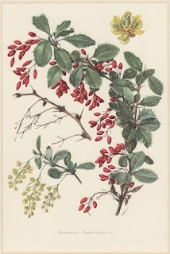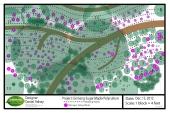Wondering if anyone here has read this new book...
"
Invasive Plant Medicine", by Timothy Lee Scott
The Ecological Benefits and Healing Abilities of Invasives
-----------------------------------------------------------
The Paradox of Invasive Plants
By Timothy Lee Scott
“Every plant is a teacher-
But as in every crowd,
There are always
A few loudmouths.”
Dale Pendell, Living with Barbarians
Many years ago, my wife imparted the idea in me “there is no such thing as a weed”, and from then on I’ve tried to follow the assertion of Ralph Waldo Emerson that a weed is “a plant whose virtues have not yet been discovered.” As a practicing herbalist, with training in Chinese and Western herbal medicine, I recognized these prolific plants deemed ‘invasive’ as valuable healing remedies that have documented
medicinal uses for thousands of years. A few years back I began writing an article to vent my frustrations to counter the mainstream version of these plants as insidious, noxious species sweeping over our lands with vengeance and malice, claiming no benefit to the landscape. Through my deepening with these plants, I learned that these opportunistic species are providing essential ecological functions for the Earth by protecting, enhancing, and cleaning the soil,
water, and air in which they live. This has lead to my adventure into writing a book to demonstrate the benefits of ‘invasive’ plants, and to uncover the origins of this fallacy of the ‘bad’ plant.
Or as some surmise about the ‘plague’ of ‘invasive species’: ‘insidious’, ‘evil’, ‘destructive’, ‘threatening’, ‘pervasive’ ‘pollution’…
Today’s ‘War on Invasives’ is full of ‘scientific’ theories and far-reaching policies based on opinions of ‘good’ plants verses ‘bad’ plants, in which the federal government, various corporations, nature-based organizations, and the puritanical public allocates billions of dollars trying to control the wilds of Nature. Deadly herbicides, destructive removal policies, and a hate mentality divert vast resources that could be better spent on more imperative issues like habitat preservation, studying plant medicines, renewable resources, and repopulating the
land with those unique plants that are on the brink of extinction. This war results from individuals and Big Business with vested interests, who have created the belief that the movement of a new, ‘exotic’ plant species entering a ‘native’ ecosystem is harmful to the surrounding inhabitants.
All plants have been on the move for hundreds of millions of years with numerous factors helping them along into areas in which they did not previously inhabit. The idea of a weed was born with the invention of the ‘crop’ some 10,000 years ago, as a plant that interfered with agriculture. The nature of a weed is opportunistic and we, as humans, have created enormous holes of opportunity for these plants to fill. They have adapted to be at peoples side, waiting for those favorable times to cover the exposed soils we are continually creating. Weeds have evolved to withstand the punishments that humans unleash upon them, with ever-changing genetics of form, function, and transmutation.
The plants considered ‘invasive’ today were brought here and spread around with the help of people, and were cherished for food, medicine, ornament, soil enhancement, and scientific curiosity. Over time though, these plants have ‘escaped’ into the wilds and have found an ecological niche, in dynamic equilibrium, amongst the different species within the landscape.
Within their niche, all plants serve ecological functions for their environment. Mullein, for example, will blanket the land where fires cleared down forests. This appears as though the plant is ‘invading’ the land, but after a year or two, new species emerge and diversity expands. Mullein has acted as a kind of Earth balm that eases and covers with its leaves the internal burns and helps regenerate new growth- which it also happens to do for the human lungs.
Forests are the lungs of the Earth, you know.
And while some plants provide food and medicine for inhabitants, some protect the land after improper clearing (Blackberry, Barberry, Wild
Rose), some cleanse the water (Common Reed, Purple Loosestrife, Water Hyacinth), some rejuvenate degraded lands (Wild Mustard, Russian Olive, Scotch Broom), and some breakdown and clean up toxins and pollutants from the soil (Japanese Knotweed, Salt Cedar, Kudzu) and air (Tree of Heaven, English Ivy).
The plants are here for a reason. They are here to serve essential ecological functions, and they are here for us to use as medicine.
With the widespread appearance of these plants, we find the remedies growing all around us to cure our modern ills. The present day ‘invasion’ of plants appears to parallel the epidemic movement of pathogenic influences, revealing the symbiotic relationship between plants and disease. The plants are cleaning the technological, industrial spills and healing the toxic and pathogenic illnesses. They are offering economic opportunities for impoverished communities and providing restoration for both the land and endangered medicinal plants. The rampant wetland plant Common Reed has been found to effectively clean sewage waste, and remove 15 heavy metals and at least 11 common pollutants from the water in which it grows. We see invasive plants arriving to treat invasive, endemic disease, like Japanese Knotweed spreading in the same trajectory and at the same rate as Lyme disease throughout North America. Kudzu, nicknamed the ‘plant that ate the south’, is an endless supply of biomass and the
roots are a nearly perfect biofuel, while also providing food, fodder, and medicine for economic potentials.
And we find powerful plant remedies to replace the endangered individuals that have been over-harvested for medicine, disturbed by development, and poisoned with industrial progress. There is Siberian Elm as a substitute for Slippery Elm, Barberry for Goldenseal, and Purple Loosestrife for Eyebright.
So…
Nature is in constant flux. Landscapes do not stay the same. Plants have an intelligence of their own. And we have created habitats in which these ‘exotics’ flourish. I do know that many of our beloved places harbor these uninvited guests, but maybe we
should let them have their space, allow them to play out their role, and make use of these plants when we can.
For they are asking to be of service with their abundance.
These opportunistic plants have staked claims on these places and parade around trying to get our attention. While much noise is made about these persistent plants, there is a silent story being told, with an important message being conveyed.
Though, so many times, the messenger has been killed.
May we all come to our senses, and begin listening to these bountiful green teachers of the land, who speak with an ancient eloquence of deep ecological understanding.
-------------------
One version of this article can be found in the United Plant Savers, Journal of Medicinal Plant Conservation, Winter 2010; p. 16-17.

 7
7








 1
1























